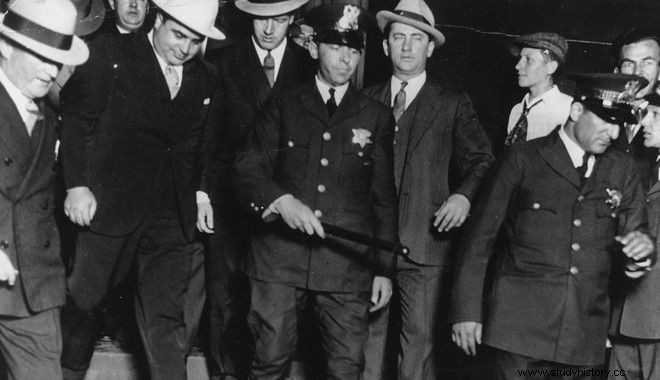Alfonso "Al" Capone, "Marked", or simply a synonym and symbol of the word "gangster" and "mafioso". The legend of the most notorious criminal in modern US history lives on to this day and continues to inspire biopic directors and writers, shedding light on the dark parts of his life.
One such has been released since May 12 on on demand platforms, directed by Josh Trank and starring the well-known British actor, Tom Hardy, who starred among others in "Peaky Blinders". The film, which was released earlier, before it was played on the big screen due to the coronavirus pandemic, gives us the opportunity to "dust off" and unravel the thread of his life and prosperity in organized crime, which he "ruled" and spread on his streets Prohibition-era Chicago (1920-1933). The thread was unraveled, first by his sentence to 11 years in prison in May 1931 and then cut when, weakened and in a bad mental state by syphilis, he died at the age of 48. This period of "decline" and the years of "decline" preoccupy Trank's film.
Moving to Chicago and "getting to know" crime
He was born a year before the turn of the 20th century, on January 17, 1899, in Brooklyn, New York, having eight other siblings. The Italian-American gangster began to show his first violent instincts when, at the age of 14, he dropped out of school (rumor has it that he beat up one of his teachers) and began to join gangs before he was even an adult. A few years later, after moving to Chicago (along with his family, his wife and their young son) they are America's No. 1 gangster, having become rich thanks to alcohol smuggling, prostitution and gambling. And of course, tax evasion. Police bribes and his guard by 1,000 armed men had made him untouchable and untouchable by the law. At least until the "Valentine Massacre".

Having adopted the life and earned the designation of "gangster" from an early age, Capone's heyday was not long in coming, with the help of his mentor, Johnny Torio. This started in New York and culminated in Chicago, where it settled in 1920, immediately after Torio's departure, with the baton now passing into Capone's hands. Prohibition exploitation, violence, and arms trafficking created an estimated $100 million fortune, now controlling brothels and entertainment venues, with the connivance of Chicago's mayor, whom he was also rumored to have bribed.

The St. Valentine Massacre
February 14, 1929 went down in history as the greatest crime in modern history. It was to be, however, also the beginning of the end for the lawlessness and empire of the "Marked", as he was nicknamed (legend says that the scar on his left cheek was made by a patron of an inn). On that bloody February 14th, Capone's men disguised themselves as policemen and stormed a garage killing seven men of George Moran, a gang leader, Capone's enemy who was also the target of that attack. This mass murder was also the reason the authorities were looking for to arrest Capone. The first attempt hit a "wall" after the charges against him fell flat and Capone had already acquired the reputation of the most notorious but also "relentless" in the unsuccessful efforts of the police thug. It didn't last long..

The fall and martyrdom
A year later (1931), the investigations of the authorities and the furious attempt to arrest him bore fruit. With the evidence sufficient and each bribery operation not having the response of previous years, Capone is sentenced to 11 years in prison and a fine of $50,000. He was transferred to the prisons of Atlanta and then Alcatraz, where in 1935 he began to have syphilitic paranoia that subsequently created mental problems and his doctor reported that Capone had the mental abilities of a 12-year-old child. He was transferred to a hospital in California, while in 1939 he was released due to health problems and with a guarantee of almost 38,000 euros.
He was transferred to a mental hospital, where he lived the remaining years of his life, from which he left at the age of 48 (January 25, 1947), having suffered from heart problems (cause of death), paranoia and nightmares, in the midst of which it is rumored that he often was calling the name "Jimmy". The name of one of the victims of the St. Valentine massacre.
